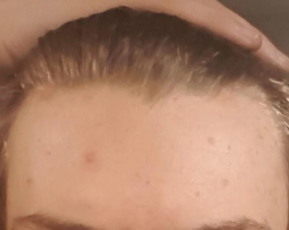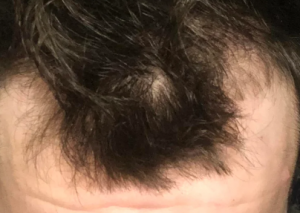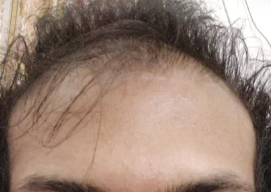I did not realize not taking it for 2.5 months would cause my hair fall to go into overdrive. If I continue again for the next 2 yrs will I regain what has fallen in the last 2.5 months?
I’ve been on 1mg fin a day for a couple weeks now. I read other opinions saying it’s best to wait about six months so you can more accurately assess whether fin is working. But most people on here seem to start minox and fin at the same time.
These two drugs have different mechanism of action so taking both at the same time increases your odds of getter hair growth, especially if you are younger than 25.
Fully bald father and a son with a full head of thick hair? What do you think Dr. Rassman?
Inheritance from the mother’s side of the family is likely here. He could have inherited his father’s maternal hair as well.
It would be interesting to read some studies about baldness in identical twins, since they share the same dna, in order to asses to what extent the previous statement is true.
I have had many identical twins come in to see me, some for hair transplants. I have written about them and generally my writings might satisfy your curiosity. You can find them here: https://baldingblog.com/?s=identical+twins
I took my first 0.25mg of fin yesterday, and today I can’t get an erection. I have no idea if its the compounding fear in the back of my head to check if I have side effects that is preventing my dick to get hard, but I struggle to get “into” porn that would usually get my blood pumping to my member almost immediately. Again, have no idea if its fin or if its in my head, but still I want to wait out the finasteride and see if my dick gets hard again. If it does, then its the fin that caused the ED.
With ED developing in just one day, I suspect you are dealing with a powerful placebo effect, rather than a drug effects; nevertheless, it should be out of your system in less than one month, but I have seen lingering effects last 2-3 months on occasion. I would stop the finasteride.
In a recent published paper in the Journal or Nutrients, by Ysinghua University in Beijing, identified a new link between men who drink excess amounts of soda (sugary drinks with or without artificial sweeteners) and even energy drinks with hair loss. The study was large. We have long blamed sugar and artificial sweeteners for many human diseases. This report is a new alarm showing that excess sugars can even be an accelerant for balding.
Finasteride usually start quickly by reducing shedding and then stopping or slowing the hair loss in a few months. Reversal, if it is to occur, will happen between 4-18 months. Some men don’t ever see new growth and have to accept slowing the loss of stopping the hair loss. A few men will find increased shedding when they start taking finasteride. This is a sign that it is working so i tell these men not to worry, just be patient.
Is there a known correlation between patient size, weight, height and appropriate oral min dosage or does it vary regardless you think?
I am not familiar with weight or height considerations for oral minoxidil. A dosage between 1.25 and 2.5 mgs daily is the correct dose with the least potential cardiovascular side effects
What’s the normal, to-be-expected shedding during the first month on finasteride? Mine is at least 30 hairs every day, and even though I knew some drawback should be expected, I’m getting a little worried. Is this really normal?
Shedding indicates that you will respond to the drug. Keep going
Is genetic balding being caused by an inflammatory response? So what about practices that reduce inflammation vs taking medication to suppress DHT?
There are conditions called Lichen Planopilaris or Frontal Fibrosing Alopecia which can cause balding in men. These autoimmune diseases are now being recognized in men who present with balding and a lot of itching. The diagnosis is made by biopsies of two areas, the frontal area where the balding is occurring and the donor area in the back of the head. There is no formal proof that genetic balding itself is an inflammatory disease so the standard approach to DHT management at the hair follicle level is still our main treatment modality.
https://www.imperial.ac.uk/news/242531/scars-mended-using-transplanted-hair-follicles/
The benefits of a hair transplant into atropic skin (long term balding scalp ‘skin’ is a good example) of what is seen after a hair transplant is performed. The scalp which is often paper thin, gets thicker and this article shows why. Many of the support infrastructure that is present in hairy scalp is not present in bald scalps to the degree that is ‘normal’; however, when a hair transplant is done, these elements repopulate again . I have read article where someone with leg ulcers that will not heal are transplanted with healthy scalp hairs, and they regrow skin to cover these ulcers which have often been refractors to traditional treatments. It probably can also be performed on decubitus ulcers for people who have been bedridden for long periods of time.
Wondering if anyone has heard of microneedling creating problems with a hair transplant by creating scar tissue or something like that. Would love to add microneedling to my routine.
Microneedling in a recently transplanted person might introduce folliculitis as an operative complication. I wouldn’t recommend it. There is no point in doing it after a hair transplant is done.






